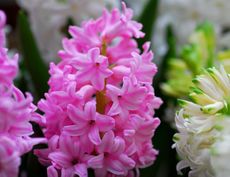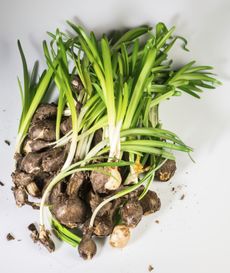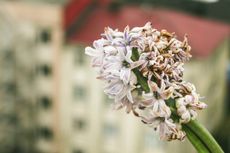Hyacinth Bud Drop: Why Hyacinth Buds Fall Off


Hyacinths are the harbinger of warm weather and the herald of a season of bounty. Bud problems with hyacinth are rare but occasionally these spring bulbs fail to bloom. Finding out why hyacinth buds fall off or, worse, why they never formed buds in the first place, can take some sleuthing. Various insects and animals find buds a tasty addition to their early spring diet while improper chilling could cause hyacinth flower problems. If you are sure you picked good bulbs and they are situated properly, get down on your hands and knees and find out the real reason your flowers have gone missing.
Why Hyacinth Buds Fall Off
Spring bulbs need a period of at least 12 to 15 weeks of chilling. This helps bulbs break dormancy and sprout a vigorous root system. Hyacinths are normally planted in fall in order to allow nature to provide this chilling period. Alternately, you can purchase pre-chilled bulbs and plant in spring. If your buds are forming but dropping before they have a chance to open, the cause may be in your soil. Improperly drained soil is a death knell for most bulbs. It promotes rot which can stop growth in its tracks. Another potential cause is poor soil nutrition. Always incorporate a good bulb food at planting to give your bulbs the best chance at sprouting and blooming. In addition, over time, bulbs naturalize and form bulblets which grow into full bulbs within a couple of years. The old bulbs will stop forming flowers, but never fear, the bulblets will soon be performing and a new crop of flowers will form.
Hyacinth Blooms Dropping Off from Pests
Tender shoots are irresistible food for animals that have survived the lean winter months. Outdoor hyacinth plants are prey to:
A very common condition where flower bulbs simply disappear is caused by cutworms. Cutworms don’t often bother flower bulbs but, on occasion, they will come in the night and simply snip and chomp away a tender bud. More likely causes for sudden bud problems with hyacinth are animals. Deer and other grazers eat tender shoots like candy and the forming bud is especially delicious. Usually the animal will take the entire plant, greens and all, but sometimes it is just the flower. Although animal pests can take a serious chunk out of your bulb patch, they do no lasting harm to the bulb itself unless you are plagued by digging rodents. Use repellents or cover the bulb patch with chicken wire or a row cover to prevent hyacinths from becoming a midnight snack.
Other Hyacinth Flower Problems
Hyacinth bud drop is a rare problem. Hyacinths are hardy bulbs with few pest or disease issues. Hyacinth blooms dropping off at the end of the season signal the time for the foliage to gather energy and recharge the bulb. Blooms only last a few weeks and then fade and die, raining the tiny florets to the ground as they go. In order to ensure a future crop of blooms, it is a good idea to divide a patch every two to three years. Allow the foliage to persist until it starts to yellow and then dig up the bulbs. Remove any with rot or disease and pick out the largest bulbs. Replant these in well worked soil that has been amended with organic supplements. This will allow the largest, healthiest bulbs to thrive without the sapping effect of an overcrowded patch.
Gardening tips, videos, info and more delivered right to your inbox!
Sign up for the Gardening Know How newsletter today and receive a free download of our most popular eBook "How to Grow Delicious Tomatoes."

Bonnie Grant is a professional landscaper with a Certification in Urban Gardening. She has been gardening and writing for 15 years. A former professional chef, she has a passion for edible landscaping.
-
 Urban Beekeeping Guide: Top Tips For Raising Bees In The City
Urban Beekeeping Guide: Top Tips For Raising Bees In The CityUrban beekeeping can be a rewarding and appreciated pastime, but first be sure it’s legal in your city and learn the ropes of beekeeping.
By Mary Ellen Ellis
-
 2024 Plant Of The Year: Why Experts Say Philodendron Is The “It” Plant Of The Year
2024 Plant Of The Year: Why Experts Say Philodendron Is The “It” Plant Of The YearWe aren’t surprised that philodendron was designated the plant of the year. Versatile, easy-care and lovely, it’s the houseplant of the year 2024!
By Bonnie L. Grant
-
 Hyacinth Bulb Itch – What To Do For Hyacinth Skin Allergy
Hyacinth Bulb Itch – What To Do For Hyacinth Skin AllergyHyacinth is a popular fall planted bulb for cheerful, fragrant spring blooms. These flowers help to drive away winter glooms. Unfortunately, hyacinth irritation can be an issue. Learn more about this skin problem, referred to as hyacinth bulb itch, in the following article.
By Mary Ellen Ellis
-
 Growing Amethyst Hyacinths: Information On Amethyst Hyacinth Plants
Growing Amethyst Hyacinths: Information On Amethyst Hyacinth PlantsGrowing Amethyst hyacinths (Hyacinthus orientalis ‘Amethyst’) couldn’t be much easier and, once planted, each bulb produces one spiky, sweet-smelling, pinkish-violet bloom every spring, along with seven or eight big, shiny leaves. Learn more in this article.
By Mary H. Dyer
-
 Hyacinth Seed Propagation – How To Grow Hyacinths From Seed
Hyacinth Seed Propagation – How To Grow Hyacinths From SeedAs hyacinth flowers fade and small green seed pods begin to form in their place, you may wonder, can you propagate hyacinth seeds? Click this article to learn about saving hyacinth seed and hyacinth seed propagation.
By Darcy Larum
-
 Curing Hyacinths: When To Dig Up Hyacinth Bulbs For Storing
Curing Hyacinths: When To Dig Up Hyacinth Bulbs For StoringIt's important not to dig up your hyacinth bulbs at the wrong time, or else your bulbs may not have enough energy to sprout. Learn about hyacinth bulb curing and storing hyacinth bulbs in the article that follows. Click here for more info.
By Liz Baessler
-
 Propagating Hyacinth Offsets – How To Propagate Bulbs Of Hyacinth
Propagating Hyacinth Offsets – How To Propagate Bulbs Of HyacinthAlthough most gardeners find it easier and faster to purchase hyacinth bulbs, hyacinth propagation by seeds or offset bulbs is easier than you may think. Want to learn more about propagating and growing hyacinth bulbs? Click here.
By Mary H. Dyer
-
 Container Grown Hyacinths: How To Plant Hyacinth Bulbs In Pots
Container Grown Hyacinths: How To Plant Hyacinth Bulbs In PotsHyacinths are famous for their pleasant fragrance. They also grow very well in pots, perfuming a patio, a walkway, or a room in your house. Learn how to plant hyacinth bulbs in pots in this article.
By Liz Baessler
-
 Indoor Hyacinth Care: Caring For Hyacinth Houseplants Post Flowering
Indoor Hyacinth Care: Caring For Hyacinth Houseplants Post FloweringBecause of their attractive flowers and delicious smell, potted hyacinths are a popular gift. Once they?re done blooming, though, don?t rush to throw them away. With a little care, you can keep your indoor hyacinth after blooming. This article will help.
By Liz Baessler
-
 My Hyacinth Is Turning Brown – Caring For Browning Hyacinth Plants
My Hyacinth Is Turning Brown – Caring For Browning Hyacinth PlantsHyacinths make great indoor or outdoor plants and are harbingers of spring, but when they start turning brown, these cheery faces are suddenly a reason for panic. Find out if your hyacinth has a real problem or if it's just going through its normal lifecycle in this article.
By Kristi Waterworth